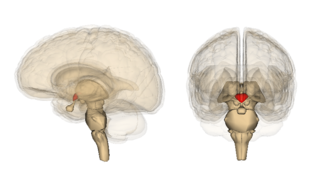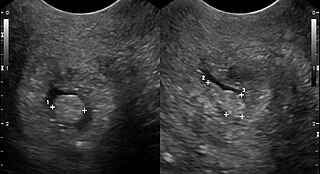Related Research Articles
An esophageal motility disorder (EMD) is any medical disorder causing difficulty in swallowing, regurgitation of food and a spasm-type pain which can be brought on by an allergic reaction to certain foods. The most prominent one is dysphagia.

Eclampsia is the onset of seizures (convulsions) in a woman with pre-eclampsia. Pre-eclampsia is a disorder of pregnancy in which there is high blood pressure and either large amounts of protein in the urine or other organ dysfunction. Onset may be before, during, or after delivery. Most often it is during the second half of pregnancy. The seizures are of the tonic–clonic type and typically last about a minute. Following the seizure there is typically either a period of confusion or coma. Complications include aspiration pneumonia, cerebral hemorrhage, kidney failure, pulmonary oedema, HELLP syndrome, coagulopathy, abruptio placentae and cardiac arrest. Pre-eclampsia and eclampsia are part of a larger group of conditions known as hypertensive disorders of pregnancy.

Wernicke encephalopathy (WE), also Wernicke's encephalopathy, or wet brain is the presence of neurological symptoms caused by biochemical lesions of the central nervous system after exhaustion of B-vitamin reserves, in particular thiamine. The condition is part of a larger group of thiamine deficiency disorders that includes beriberi, in all its forms, and alcoholic Korsakoff syndrome. When it occurs simultaneously with alcoholic Korsakoff syndrome it is known as Wernicke–Korsakoff syndrome.

Hematuria or haematuria is defined as the occurrence of blood or red blood cells in the urine. The word hematuria is derived from Greek haima (αἷμα) "blood" and ouron (οὖρον) "urine". Hematuria can be visible to the naked eye and may appear red or brown, or it can be microscopic. The origin of the blood that enters and mixes with the urine can arise from any anatomical site within the urinary system, including the kidney, ureter, urinary bladder, and urethra, and in men, the prostate. Common causes of hematuria include urinary tract infection (UTI), kidney stones, viral illness, trauma, bladder cancer, and exercise. The underlying causes of hematuria can be divided into glomerular and non-glomerular causes, referring to the involvement of the glomerulus of the kidney. Notably, not all red urine is hematuria. Other substances such as certain medications and foods can cause urine to appear red. Menstruation in women may also cause the appearance of hematuria and may result in a positive urine dipstick test for hematuria. Additionally, a urine dipstick test may be falsely positive for hematuria due to other substances in the urine such as myoglobin during rhabdomyolysis. A positive urine dipstick test should be confirmed with microscopy, where hematuria is defined by three of more red blood cells per high power field. When hematuria is detected, a thorough history and physical examination with appropriate further evaluation can help determine the underlying cause.

Acute kidney injury (AKI), previously called acute renal failure (ARF), is a sudden decrease in kidney function that develops within 7 days, as shown by an increase in serum creatinine or a decrease in urine output, or both.
Cerebral salt-wasting syndrome (CSWS), also written cerebral salt wasting syndrome, is a rare endocrine condition featuring a low blood sodium concentration and dehydration in response to injury (trauma) or the presence of tumors in or surrounding the brain. In this condition, the kidney is functioning normally but excreting excessive sodium. The condition was initially described in 1950. Its cause and management remain controversial. In the current literature across several fields, including neurology, neurosurgery, nephrology, and critical care medicine, there is controversy over whether CSWS is a distinct condition, or a special form of syndrome of inappropriate antidiuretic hormone secretion (SIADH).

Metabolic acidosis is a serious electrolyte disorder characterized by an imbalance in the body's acid-base balance. Metabolic acidosis has three main root causes: increased acid production, loss of bicarbonate, and a reduced ability of the kidneys to excrete excess acids. Metabolic acidosis can lead to acidemia, which is defined as arterial blood pH that is lower than 7.35. Acidemia and acidosis are not mutually exclusive – pH and hydrogen ion concentrations also depend on the coexistence of other acid-base disorders; therefore, pH levels in people with metabolic acidosis can range from low to high.

Mycosis fungoides, also known as Alibert-Bazin syndrome or granuloma fungoides, is the most common form of cutaneous T-cell lymphoma. It generally affects the skin, but may progress internally over time. Symptoms include rash, tumors, skin lesions, and itchy skin.

Codocytes, also known as target cells, are red blood cells that have the appearance of a shooting target with a bullseye. In optical microscopy these cells appear to have a dark center surrounded by a white ring, followed by dark outer (peripheral) second ring containing a band of hemoglobin. However, in electron microscopy they appear very thin and bell shaped. Because of their thinness they are referred to as leptocytes. On routine smear morphology, some people like to make a distinction between leptocytes and codocytes- suggesting that in leptocytes the central spot is not completely detached from the peripheral ring, i.e. the pallor is in a C shape rather than a full ring.

Thyroid disease is a medical condition that affects the function of the thyroid gland. The thyroid gland is located at the front of the neck and produces thyroid hormones that travel through the blood to help regulate many other organs, meaning that it is an endocrine organ. These hormones normally act in the body to regulate energy use, infant development, and childhood development.

Portal vein thrombosis (PVT) is a vascular disease of the liver that occurs when a blood clot occurs in the hepatic portal vein, which can lead to increased pressure in the portal vein system and reduced blood supply to the liver. The mortality rate is approximately 1 in 10.
Oral allergy syndrome (OAS) is a type of food allergy classified by a cluster of allergic reactions in the mouth and throat in response to eating certain fruits, nuts, and vegetables that typically develops in adults with hay fever.
A major depressive episode (MDE) is a period characterized by the symptoms of major depressive disorder. Those affected primarily have a depressed mood for at least two weeks or more, and a loss of interest or pleasure in everyday activities. Other symptoms include feelings of emptiness, hopelessness, anxiety, worthlessness, guilt, irritability, changes in appetite, problems concentrating, remembering details or making decisions, and thoughts of suicide. Insomnia or hypersomnia, aches, pains, or digestive problems that are resistant to treatment may also be present. The description has been formalized in psychiatric diagnostic criteria such as the DSM-5 and ICD-10.

Prepatellar bursitis is an inflammation of the prepatellar bursa at the front of the knee. It is marked by swelling at the knee, which can be tender to the touch and which generally does not restrict the knee's range of motion. It can be extremely painful and disabling as long as the underlying condition persists.

A dislocated shoulder is a condition in which the head of the humerus is detached from the shoulder joint. Symptoms include shoulder pain and instability. Complications may include a Bankart lesion, Hill-Sachs lesion, rotator cuff tear, or injury to the axillary nerve.

Accelerated idioventricular rhythm is a ventricular rhythm with a rate of between 40 and 120 beats per minute. Idioventricular means “relating to or affecting the cardiac ventricle alone” and refers to any ectopic ventricular arrhythmia. Accelerated idioventricular arrhythmias are distinguished from ventricular rhythms with rates less than 40 and those faster than 120. Though some other references limit to between 60 and 100 beats per minute. It is also referred to as AIVR and "slow ventricular tachycardia."

A cervical polyp is a common benign polyp or tumour on the surface of the cervical canal. They can cause irregular menstrual bleeding but often show no symptoms. Treatment consists of simple removal of the polyp and prognosis is generally good. About 1% of cervical polyps will show neoplastic change which may lead to cancer. They are most common in post-menarche, pre-menopausal women who have been pregnant.

Ancylostoma braziliense is a species of hookworm belonging to the genus Ancylostoma. It is an intestinal parasite of domestic cats and dogs. Severe infection is often fatal to these pets, especially in puppies and kittens. The infection is particularly endemic in the southern United States. It is most often confused with the zoonotic hookworm species Ancylostoma ceylanicum because of their uncanny resemblance.
Theca lutein cyst is a type of bilateral functional ovarian cyst filled with clear, straw-colored fluid. These cysts result from exaggerated physiological stimulation due to elevated levels of beta-human chorionic gonadotropin (beta-hCG) or hypersensitivity to beta-hCG. On ultrasound and MRI, theca lutein cysts appear in multiples on ovaries that are enlarged.

Bigeminy is a cardiac arrhythmia in which there is a single ectopic beat, or irregular heartbeat, following each regular heartbeat. Most often this is due to ectopic beats occurring so frequently that there is one after each sinus beat, or normal heartbeat. The two beats are figuratively similar to two twins. For example, in ventricular bigeminy, a sinus beat is shortly followed by a premature ventricular contraction (PVC), a pause, another normal beat, and then another PVC. In atrial bigeminy, the other "twin" is a premature atrial contraction (PAC).
References
- ↑ Kim, E. Edmund (2009-01-01). "Current Medical Diagnosis and Treatment". Journal of Nuclear Medicine. 50 (1): 165. doi: 10.2967/jnumed.108.056002 . ISSN 0161-5505.
- ↑ Papadakis, Maxine A.; Rabow, Michael W.; McQuaid, Kenneth R.; McPhee, Stephen J. (2021-09-14). CURRENT Medical Diagnosis and Treatment 2022. McGraw-Hill Education. ISBN 978-1-264-26938-9.